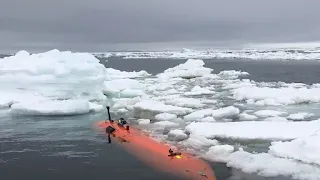Exploring the Depths of the Dotson Ice Shelf
In 2022, a pioneering mission led by scientists from the International Thwaites Glacier Collaboration (ITGC) utilized an autonomous underwater vehicle (AUV) named Ran to investigate the uncharted depths beneath the Dotson Ice Shelf in West Antarctica. This mission marked a significant advancement in our understanding of the rapidly changing dynamics of the region, which has become a key area for climate research. The project not only provided crucial insights into how glaciers are melting more quickly due to underwater currents but also revealed hidden structures within the ice shelf itself. However, the mission took an unexpected turn when Ran vanished beneath the ice, leaving researchers with a blend of valuable discoveries and lingering questions. The findings from this study were published in the journal *Science Advances, shedding light on the future of Antarctica’s ice sheet and the urgent challenges of studying climate change in such extreme environments.
The Mission's Objectives
The primary aim of the mission was to investigate the factors contributing to the accelerated melting of Antarctica’s ice shelves, particularly the Dotson Ice Shelf. Scientists recognize that ice shelves are vital for stabilizing glaciers and preventing them from flowing directly into the ocean, which would contribute to rising sea levels. However, the complex interactions between these shelves and the underwater currents that affect their melting rates remain poorly understood. To address this, the Ran AUV was designed to navigate deep beneath the ice, mapping the underside of the Dotson Ice Shelf and collecting previously inaccessible data.
Over 27 days, Ran covered more than 600 miles, mapping approximately 50 square miles of ice. The vehicle employed advanced sonar technology, including pulsed sound waves, to create detailed images of the ice’s underside. This effort allowed researchers to identify previously unknown features beneath the shelf, such as teardrop shapes, icy plateaus, and intricate erosion patterns. The high-resolution data significantly enhanced our understanding of the Dotson Ice Shelf's behavior and the forces at work in this critical region. The mission uncovered astonishing secrets hidden beneath Antarctica’s ice—only for Ran to disappear without a trace!
Revealing New Insights into Glacier Dynamics
The results from the Ran mission challenge many long-held beliefs about glacier behavior. Anna Wåhlin, the study's lead author, highlighted the significance of the data gathered by the autonomous underwater vehicle (AUV). “In the past, we relied on satellite data and ice cores to track glacier changes over time,” Wåhlin stated in a press release. “By maneuvering the submersible into the cavity, we obtained high-resolution maps of the ice's underside. It’s akin to seeing the far side of the Moon.” These new maps provide intricate details about the interactions between glaciers, ice shelves, and the ocean, shedding light on the factors contributing to their rapid melting.
One of the most fascinating findings was the notable difference in melt rates between the western and eastern sections of the Dotson Ice Shelf. The thicker eastern section appears to be melting more slowly than its western counterpart. Researchers propose that this discrepancy may be linked to a phenomenon known as modified Circumpolar Deep Water (mCDW). This water mass, a blend of Pacific and Indian Ocean waters, interacts with the ice base and accelerates melting. By measuring underwater currents and observing the high melting rates of fractures in the glacier, the Ran team collected valuable data that could enhance existing models of ice shelf dynamics.
The Unexpected Disappearance of Ran
While the initial phase of the mission was successful, the team encountered an unforeseen challenge when Ran failed to return during its second deployment in 2024. The autonomous underwater vehicle (AUV) was dispatched back to the Dotson Ice Shelf to monitor changes in the ice structure, but it vanished beneath the ice before reaching the designated rendezvous point. The team suspects that Ran may have either become lodged on the ocean floor or been interfered with by inquisitive seals, a common occurrence in Antarctica's frigid waters.
Despite the setback, Wåhlin remained optimistic about the data already collected. “While we obtained valuable information, it wasn’t everything we had hoped for,” Wåhlin stated. “These scientific advancements were made possible by the unique capabilities of Ran.” She further highlighted the mission's significance, noting, “This research is essential for understanding the future of Antarctica’s ice sheet, and we aim to replace Ran to continue this vital work.” Although the loss of the submersible is a considerable setback for the research team, it has not deterred their commitment to studying Antarctica’s ice shelves.



